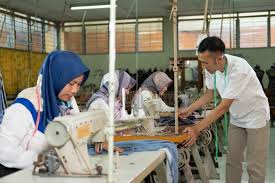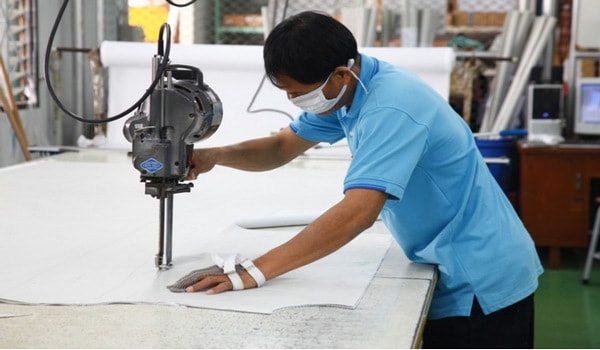Free Cutting Supervisor Course(1year Diploma)
Cutting Supervisor Course click here
The Cutting Supervisor is a job role in cutting section carrying out tasks as overall incharge of the cutting department function monitoring production and quality of cutting processes.
Brief Job Description:-Supervisor (cutting) is responsible for monitoring cutting operations, quality and smooth running of cutting processes with junior management cadres working as a team.
Personal Attributes:- He/she should have good interpersonal skills, vigilant and good eye sight to detect defects or abnormality in the process. He/she should have basic mathematical skills, particularly making arithmetical calculations and measurement. He/she should possess good oral communication skills in vernacular Cutting Supervisor Course.


Planning of the process steps for cutting Cutting Supervisor Course:-
PC1. Review orders received from Production Planning for cutting as per style/product category/class
PC2. Check materials availability in suitable form and quantity
PC3. Allocate cutting tables as per plan and priority
PC4. Allocate spreaders and cutters as per style, quality and cutting skills availability
PC5. Set cutting targets and required quality standards
PC6. Allocate manpower (operators, helpers, relievers etc.) based on skill-set and suitability for cutting processes or sub-processes
Different preparatory process steps for cutting:- PC1. Ensure fabric received for cutting is checked for visible faults like stains, slub, etc.
PC2. Ensure fabric specific to cutting plan assigned to definite styles/quality is allocated to same quality/style.
PC3. Ensure the marker received is complete in all aspects like grain line, notches, part name, clarity of markings, complete for all components etc.
PC4. Ensure fabrics are laid with due consideration to the prints (if present) and defects detected in texture/style
PC5. Ensure the patterns and marker are laid properly on the fabric Cutting Supervisor Course.
PC6. Ensure availability and appropriate cutting tools and equipment for cutting

Supervision of the operation of cutting processes Cutting Supervisor Course:-
PC1. Ensure the workflow of the cutting process is smooth and fast
PC2. Ensure the workload for cutting is equitably distributed as per operator skill-set and performance
PC3. Ensure materials are processed as per priority against delivery schedule
PC4. Ensure standards, reference sample, templates, dies etc. are available near cutting
PC5. Ensure that the fabric is cut with precision
PC6. Ensure that all the trims and accessories for the product are cut as per the requirement
PC7. Ensure that the cut fabric is properly ticketed and bundled and delivered to respective departments
Maintain the work area as compliant to health, safety and security needs and requirements Cutting Supervisor Course:-
PC1. Keep vigilance for potential risks and threats associated with workplace and equipment like, hot iron, knife, stain removers etc.
PC2. Ensure appropriate PPE is used while operating the handheld electrical cutter with the help of mesh gloves, etc.
PC3. Establish and Ensure Process compliance to its requirements
PC4. Monitor workplace and work processes for potential risks and threats like physical injuries or disabilities, etc.
PC5. Participate in mock-drills/evacuation procedures organized at the workplace Cutting Supervisor Course.
PC6. Undertake first-aid, fire-fighting and emergency response training if asked to do so
Maintain workarea, tools and machines Cutting Supervisor Course:-

To be competent, the user/individual on the job must be able to:
PC1. Handle materials, machinery, equipment and tools safely and correctly
PC2. Use correct lifting and handling procedures
PC3. Use materials to minimize waste
PC4. Maintain a clean and hazard free working area
PC5. Maintain tools and equipment
PC6. Carry out running maintenance within agreed schedules
PC7. Carry out maintenance and/or cleaning within one’s responsibility
PC8. Report unsafe equipment and other dangerous occurrences
PC9. Ensure that the correct machine guards are in place
PC10.Work in a comfortable position with the correct posture
PC11.Use cleaning equipment and methods appropriate for the work to be carried out
PC12.Dispose of waste safely in the designated location
PC13. Store cleaning equipment safely after use
PC14.Carry out cleaning according to schedules and limits of responsibility
Comply with industry, regulatory and organizational requirements Cutting Supervisor Course:-

To be competent, the user/individual on the job must be able to:
PC1. Carry out work functions in accordance with legislation and regulations, organizational guidelines and procedures
PC2. Seek and obtain clarifications on policies and procedures, from your supervisor or other authorized personnel
PC3. Apply and follow these policies and procedures within your work practices Cutting Supervisor Course.
PC4. Provide support to your supervisor and team members in enforcing these considerations
PC5. Identify and report any possible deviation to these requirements

Guidelines for Assessment:-
- Criteria for assessment for each Qualification Pack will be created by the Sector Skill Council. Each Performance Criteria (PC) will be assigned marks proportional to its importance in NOS. SSC will also lay down proportion of marks for Theory and Skills Practical for each
PC 2. The assessment for the theory part will be based on knowledge bank of questions approved by the
SSC 3. Individual assessment agencies will create unique question papers for theory part for each candidate at each examination/training center (as per assessment criteria below)
4. Individual assessment agencies will create unique evaluations for skill practical for every student at each examination/training center based on this criteria Cutting Supervisor Course.
5. To pass the Qualification Pack, every trainee should score a minimum of 70% aggregate in a QP
6. In case of successfully passing only certain number of NOS’s, the trainee is eligible to take subsequent assessment on the balance NOS’s to pass the Qualification Pack
(Plan and organize cutting process):-
PC1. Review orders received from Production Planning for cutting as per style/product category/class
PC2. Check materials availability in suitable form and quantity
PC3. Allocate cutting tables as per plan and priority Cutting Supervisor Course.
PC4. Allocate spreaders and cutters as per style, quality and cutting skills availability
PC5. Set cutting targets and required quality standards
PC6. Allocate manpower (operators, helpers, relievers etc.) based on skillset and suitability for cutting processes or sub-processes
(Preparatory processes for cutting):-

PC1. Ensure fabric received for cutting is checked for visible faults like stains, slub, etc.
PC2. Ensure fabric specific to cutting plan assigned to definite styles/quality is allocated to same quality/style.
PC3. Ensure the marker received is complete in all aspects like grain line, notches, part name, clarity of markings, complete for all components etc
PC4. Ensure fabrics are laid with due consideration to the prints (if present) defects detected in texture/style
PC5. Ensure the patterns and marker are laid properly on the fabric Cutting Supervisor Course.
PC6. Ensure availability and appropriate cutting tools and equipment for cutting
(Supervise cutting operations):-
PC1. Ensure the workflow of the cutting process is smooth and fast
PC2. Ensure the workload for cutting is equitably distributed as per operator skillset and performance
PC3. Ensure materials are processed as per priority against delivery schedule
PC4. Ensure standards, reference sample, templates, dies etc. are available near cutting
PC5. Ensure that the fabric is cut with precision
PC6. Ensure that all the trims and accessories for the product are cut as per the requirement Cutting Supervisor Course.
PC7. Ensure that the cut fabric is properly ticketed and bundled and delivered to respective departments
(Maintain health, safety and security in the cutting department):-
PC1. Keep vigilance for potential risks and threats associated with workplace and equipment like, hot iron, knife, stain removers etc.
PC2. Ensure appropriate PPE is used while operating the handheld electrical cutter with the help of mesh gloves, etc.
PC3. Establish and Ensure Process compliance to its requirements
PC4. Monitor the workplace and work processes for potential risks and threats
PC5. Participate in mockdrills/evacuation procedures organized at the workplace Cutting Supervisor Course.
PC6. Undertake first-aid, firefighting and emergency response training if asked to do so
(Maintain workarea, tools and machines):-
PC1. Handle materials, machinery, equipment and tools safely and correctly
PC2. Use correct lifting and handling procedures
PC3. Use materials to minimize waste
PC4. Maintain a clean and hazard free working area
PC5. Maintain tools, equipments and machines
PC6. Carry out running maintenance within agreed schedules
PC7. Carry out maintenance and/or cleaning within one’s responsibility
PC8. Report unsafe equipment and other dangerous occurrences
PC9. Ensure that the correct machine guards are in place
PC10. Work in a comfortable position with the correct posture
PC11. Use cleaning equipment and methods appropriate for the work to be carried out
PC12. Dispose of waste safely in the designated location
PC13. Store cleaning equipment safely after use Cutting Supervisor Course.
PC14. Carry out cleaning according to schedules and limits of responsibility
(Comply with industry, regulatory and organizational requirements):-
PC1. Carry out work functions in accordance with legislation and regulations, organizational guidelines and procedures
PC2. Seek/Obtain/Provide clarifications on policies and procedures, from your supervisor or other authorized personnel
PC3. Apply and follow these policies and procedures within your work practices
PC4. Provide support to your supervisor and team members in enforcing these considerations
PC5. Identify and report any possible deviation to these requirements

Understand Production Specification and Process:-
The manufacturing processes
· skill and proficiency level for each
· operation operating machines and basic
· trouble shooting alternative processes with same or
· similar output materials required by each type of
· product manufactured by the organization The raw materials defects and
· handling defects The organizations standard
· operating procedures How to identify the process and
· product problem Understanding of pmts
· Understanding operator rating
· Understanding incentive system or
wage plan
Coordinate and Plan production as per specifications and schedule:-
Knowledge of fabrics and garments
· The stitching process
· Knowledge of sewing and the
· various types of stitching required for various products. Machinery and work aids used in
· the process Organization’s standard operating
· procedures Stitching defects and handling
· defects Knowledge of quality and
· compliance requirement Buyer specific compliances
· The escalation hierarchy
· OPTIONAL IT Literacy and Specific tools
· Organization Specific ERP and
· reports to be maintained
Execute and monitor production as per the plan, schedule and quality norms:-
Basic Arithmetic and Numeric
· Calculations for analysis related to work Machine Settings and elementary
· repair in case of breakdown Organization’s standard operating
· procedures Identification of the process and
· Defects and their root causes
· product problems The escalation hierarchy relating to
· technical issues Statistical Quality Control Systems
· and their applications Quality Management Systems
Manage performance and relations with people in the group and out of the group:-
Use of work aids and handling
· techniques to enhance productivity Techniques to foster team building
· and team productivity Knowledge on Sewing and the
· various types of stitching required by various products. Improving motor coordination or
· handling techniques Systematic Training to improve
· productivity Organization’s standard operating
· procedures Stitching defects and handling
· defects The escalation hierarchy
· Knowledge on quality
Maintain tools equipment’s and machinery:-
Garment construction instructions and specifications and interpret them
· accurately Method to make use of the
· information detailed in specifications and explain the instructions Relation between work role and the
· overall manufacturing process The importance of taking action
· when problems are identified The importance of running
· Different ways of minimising waste
· maintenance. Common faults with equipment and
· the method to rectify Maintenance procedures
Comply with industry, regulatory and organizational essentials:-
Carryout work functions in
· accordance with legislation and regulations, organizational guidelines and procedures Seek and obtain clarifications on
· policies and procedures, from your supervisor or other authorized personnel Apply and follow these policies and
· procedures within your work practices Provide support to your supervisor
· and team members in enforcing these considerations Identify and report any possible
· deviation to these requirement Understand importance of effective
· communication Communicate effectively with others
· Identify and follow personal
· grooming and hygiene Follow organization procedures and
· maintain personal health and hygiene and avoid habits like ghutka, tobacco etc. Interact effectively in a group
· Manage time effectively
· Understand importance of resume
· and prepare your resume
Identify methods of first aid
· Undertake basic first aid,
· Undertake basic CPR
Understand production specification and process:-
PC1. Analyse& interpret the given tech pack or specification sheet of the garment sample to be developed
PC2. collate the required details regarding production planning and scheduling
PC3. ensure conformance of samples pattern & cut pieces as per the given specification sheet
PC4. analyze schedules and throughput of various styles
PC5. evaluate the consumption of material and accessories
PC6. get update about the bill of material for the job order
PC7. breakdown operations and prepare or interpret operation bulletin
PC8. understand machinery layout requirements for the specific products
PC9. plan quality check points and control limits
PC10.plan reduction of material and start-up losses
PC11.conduct or refer findings of pilot run
PC12.ensure all concerned people are updated of all the changes in buyer’s specification
PC13.identify skill levels of the operators for the production line
PC14.identify operators and assign them tasks as per their skill and proficiency levels
Coordinate and plan production as per specifications and schedule:-
PC1. participate in pre-production meetings and communicate proactively to develop process and product understanding
PC2. set qualitative and quantitative output target for each operation
PC3. carryout pilot run or update with the findings of the pilot run and sampling for the particular style
PC4. coordinate with planning /industrial engineering / for machine layout work aids
PC5. coordinate with corresponding departments for ensuring the right quantity and quality of material is received
PC6. allocate the operators as per their skill level for various operations
PC7. coordinate with stores/ cutting dept./ qc lab / manager in charge to ensure preparedness to meet the production target
PC8. set the process / line assembly/ batch in the sewing operation
PC9. coordinate with quality control to check initial output and set quality check points
PC10. ensure process for accuracy of input and output with regards to interdepartmental movement, vendor movement, incoming material and outgoing material
PC11. creating or complying with recording systems being used for monitor production targets
Execute and monitor production as per the plan, schedule and quality norms:-
PC1. layout / set up machines in an arrangement that makes it easier and effective for material handling
PC2. ensure all machinery work aids and handling aids are in proper condition
PC3. ensure all accessories are in the store ready for issue
PC4. ensure all quality checkpoints are in place for incoming intermediate and final stages
PC5. follow up and check the incoming material for the first few pieces
PC6. follow up and check first few pieces coming out of every operation
PC7. approve the pieces from the quality control department
PC8. verify the product as per the spec sheet
PC9. verify the product through the merchandiser for ensuring all comments from the buyer have been updated
PC10.minimize losses such as breakdown time, waiting time etc
PC11.create a mechanism / arrange for updating output periodically
PC12.monitor and maintain periodic output as per target.(qualitative and quantitative)
PC13.motivate and support team members to achieve and improve the desired level of output
PC14.make necessary changes in case of contingencies
PC15.control cost and wastage
PC16.collaborate in organizational level initiatives on quality &productivity
PC17.ensure preventive maintenance schedules are followed
Manage performance and relations with people in the group and out of the group:-
PC1. Receive work instructions and feedback from reporting manager or other seniors in a proactive manner
PC2. Communicate targets and get concurrence on targets from team members
PC3. Communicate to reporting superior about process flow improvements.
PC4. communicate and sensitize about the defects and anticipated difficulties sens
PC5. sensitize about the defects received from previous process and the losses on account of the same
PC6. communicate to reporting superior about the shortages or performance related targets
PC7. re -work based on feedback provided by superior on product, process and people
PC8. motivate and organize team members to achieve the desired results
PC9. sensitize group members on the effects of absenteeism and low productivity
productivity
PC10.monitor each individual for his performance and assist him for improvement
PC11.represent collective concerns to appropriate authorities
PC12.work with colleagues of other departments to ensure smooth process flow of input and output
PC13.communicate and discuss work flow related difficulties in order to find solutions with mutual
PC14.receive the feedback from other departments, given if any, and rework in order to complete work on time
Maintaining Tools equipments and machinery:-
PC1. ensure the machines are laid out as per the consensus between production, planning , industrial engineering
PC2. ensure the machines, work stations are in a satisfactory working condition
C3. refer to findings of pilot run or carryout pilot run
PC4. ensure work aids and attachments are as per specifications and working condition
PC5. pathways and workflow areas as per compliance requirements
PC6. ensure preventive maintenance schedules are complied with
PC7. during production ensure that breakdown does not consume much time and equipment is replaced in case of extraordinary delays
PC8. store materials and equipment are in line with manufacturer’s and organizational requirements
PC9. ensure work in process is maintained at an optimal level
PC10.ensure the storage areas are clean and clear and have been marked or labeled clearly
PC11.ensure that storage is done as per requirement
PC12.ensure that handling is done as desired
PC13.ensure that bundle tickets or identity of goods is maintained
PC14.ensure that special provisions of handling like shade sorting, size sorting is maintained
PC15.ensure ambient and required lighting is appropriate
PC16.put special check points on critical operations
PC17.develop & use templates for enhancing productivity
PC18.identify the role of central utilities like pneumatic,electrical, boilers in the production process
PC19.carry out basic and advanced machine settings
PC20.carry out machine settings with reference to utilities
PC21.understand ergonomics in working on various operation
Maintain health, safety and security at work place:-
PC1. Comply with health and safety related instructions applicable to the workplace
PC2. Use and maintain personal protective equipment as per protocol
PC3. Carry out own activities in line with approved guidelines and procedures
PC4. Maintain a healthy lifestyle and guard against dependency on intoxicants
PC5. Follow environment management system related procedures
PC6. Identify and correct (if possible) malfunctions in machinery and equipment
PC7. Report any service malfunctions that cannot be rectified
PC8. Store materials and equipment in line with manufacturer’s and organizational requirements
PC9. Safely handle and move waste and debris
PC10. Minimize health and safety risks to self and others due to own actions
PC11. Seek clarifications, from supervisors or other authorized personnel in case of perceived risks
PC12. Monitor the workplace and work processes for potential risks and threats
PC13. Carry out periodic walk – through to keep work area free from hazards and obstructions if any
PC14. Report hazards and potential risks/ threats to supervisors or other authorized personnel
PC15. Participate in mock drills/ evacuation procedures organized at the workplace
PC16. Undertake first aid, fire – fighting and emergency response training, if asked to do so
PC17. Take action based on instructions in the event of fire, emergencies or accidents
PC18. Follow organization procedures for shutdown and evacuation when required
Comply with industry , regulatory and organizational requirements:-
PC1. Carry out work functions in accordance with legislation and regulations, organizational guidelines and procedures
PC2. Seek and obtain clarifications on policies and procedures, from your supervisor or other authorized personnel
PC3. Apply and follow these policies and procedures within your work practices
PC4. Provide support to your supervisor and team members in enforcing these considerations
PC5. Identify and report any possible deviation to these requirements







